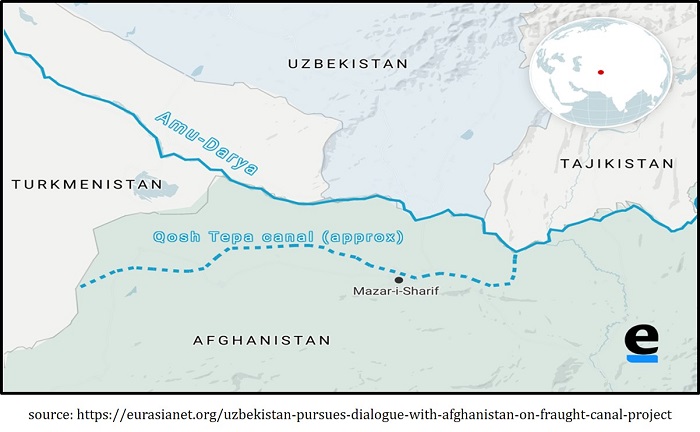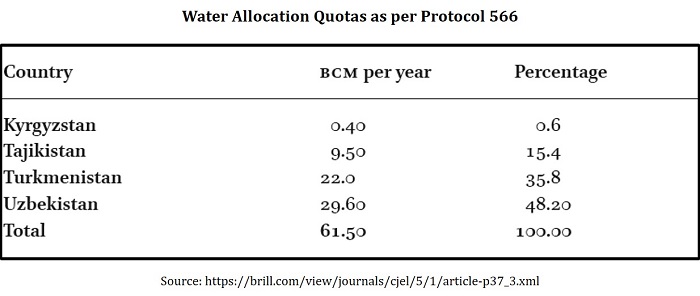In 2021, the Taliban took control of Afghanistan in an attempted military takeover that overthrew the country’s officially recognised government. The Taliban encountered little resistance in retaking control of Kabul in less unusual circumstances. However, the diplomatic isolation against the Taliban regime followed immediately. With the exception of Tajikistan, other neighbours of Afghanistan have been able to maintain cordial relations with Taliban leadership in order to maintain peace along their shared borders.
Two of Kabul’s northern neighbours, Uzbekistan and Turkmenistan, putting aside the extremist group’s contentious past with the Central Asian republics, chose to engage with them despite criticism and pressure. They hosted multiple Taliban delegations to discuss the trade, economy, and border security issues. Despite multiple border skirmishes with Taliban forces, Turkmenistan provided electricity to Kabul and had talks with them to expedite the work on the (Turkmenistan-Afghanistan-Pakistan-India) TAPI pipeline. [1] While Turkmenistan’s cooperation with the Taliban remains transactional, Uzbekistan went a step ahead. It advocated for unfreezing Afghan assets, including Afghanistan into economic, trade, and transport corridors and providing humanitarian assistance. With Uzbekistan’s support, a Regional Humanitarian Logistics Hub was established at Termez at the Tajik-Afghan border as part of UNHCR’s response to the situation in Afghanistan.
Despite a cooperative and cordial interaction, recent disagreements over using Amu Darya’s water have appeared to endanger the Taliban’s relations with the bordering Central Asian countries. The Taliban is aggressively constructing a massive canal project in northern Afghanistan, raising questions for the abovementioned water-scarce Central Asian nations about whether strategic patience with the Taliban was worth the effort.
The Qosh Tepa Canal, which is 100 meters wide and 285 km long, is named after the Qosh Tepa district in the Jawzjan province of Northern Afghanistan. The Canal is projected to help irrigate 550000 hectares of land. [2] By drawing water from the Amu Darya River, the proposed Canal has the potential to drastically affect the water availability situation in Uzbekistan and Turkmenistan. The Qosh Tepa canal, once fully operational, may prevent thousands of people in villages in Uzbekistan and Turkmenistan from having access to water. While it doesn’t seem like the Taliban, Iran, or Central Asian nations want to endanger their current level of involvement, water sharing is one issue that could impact regional dynamics. [3]

The Amu Darya is the most important water source for Afghanistan and the surrounding areas. The water from this river is mainly used for agricultural production. The Amu Darya’s total irrigated area is estimated to be 6 million hectares. It is estimated to irrigate 1.15 million hectares of agricultural land in upstream Afghanistan. The Amu Darya is used for 0.5 million hectares of land irrigation in upstream Tajikistan. Downstream countries with the most irrigated land include Uzbekistan and Turkmenistan, which use the Amu Darya to irrigate 2.3 million and 1.7 million hectares of land, respectively. Only about 0.1 million hectares of Kyrgyz land is irrigated from the water used by Amu Darya. [4]
The water allocation of Amu Darya for agricultural purposes can be traced back to the Soviet Union and even before that. Through Protocol 566, the Soviet administration allocated water from this river basin among the four Central Asian Republics (CARs): the Kyrgyz Republic, Tajikistan, Turkmenistan, and Uzbekistan. [5] Protocol 566 provisioned that Afghanistan would divert 2.1 cubic kilometers of water from the Amu Darya Basin. Post Soviet Union collapse and emergence of five independent Central Asian republics (CARs) in 1991, CARs signed the Almaty Agreement and agreed to retain the allocation quotas per the Protocol 566. At that time, CARs looked at the Taliban as an extremist outfit eyeing to take control of Kabul; therefore, expectedly, Afghanistan was excluded from regional water-sharing treaties and water management mechanisms. [6]

Now that the Canal is under construction, the Taliban argue that they have not used their fair share of water from the Amu Darya for many decades and may now use it for socioeconomic development. The Taliban leadership has supported the project’s first phase, which is 100 kilometers long, using their own funds. According to Taliban sources, over 5500 people are working simultaneously at approximately 120 locations to accelerate the execution of the task. Besides, over 3300 pieces of machinery are in service, and more than 200 local firms operate as subcontractors for the Afghanistan National Development Company. [7]
About USD 91 million will be spent on the first phase. Taliban administration plans to raise funding for the next two phases by selling mines, primarily the Dar-e-Souph Mine. The Canal is expected to carry 650 cusec (cubic meters per second) of water for the agriculture in the Balkh, Jawzjan, and Faryab provinces. As per the reports, the first phase of the Canal of around 100 km section is almost completed. [8]
Even if the Qosh Tepa is expected to make a significant economic contribution to Northern Afghanistan, it is certain to bring about a number of complications. On April 2023, “According to forecasts, in the growing season of 2023, a decrease in the volume of water resources in the Syr Darya river basin by 10-15 percent and in the Amu Darya river basin by 15-20 percent of the long-term norm is expected” [9]. The water level decrease will further exacerbate the situation in Central Asia.
A recent assessment of the Qosh Tepa Canal’s construction quality using satellite images also produced negative results. According to the study, the main strategy used during the construction phase-I was crude excavation without adequate groundwork for the Canal’s surface zones. These crude construction techniques may eventually pose a serious risk of significant water seepage and unnecessary loss. [10]
The building of the Qosh Tepa Canal also has the potential to alter the regional dynamics. The Canal, originally envisioned in the 1970s, enabling Afghanistan to redirect a substantial volume of water from the Amu Darya, could not take off due to opposition from the neighbouring countries. Despite Central Asian countries’ previous opposition, Turkmenistan and Uzbekistan’s readiness to join in negotiations is a welcome step towards promoting regional cooperation in sustainable water management. [11] However, this should be understood by the Taliban regime that the countries supporting them all along this diplomatic isolation should not be perturbed by their irrational behaviour.
The Central Asian countries have not taken any strong measures, yet they have been trying to put forward their concerns through dialogue and discussion with the Taliban. On a regional level, CARs have also tried to carry out a coordinated strategy to deal with this issue. On August 4, Turkmenistan, Tajikistan, and Uzbekistan had their first-ever trilateral meeting. Water management was a crucial subject against the backdrop of depleting water resources. The discussion emphasised the importance of developing a sustainable management system in the Amu Darya basin and strengthening “mutually beneficial cooperation” among the countries that share the river’s water. Despite this, the canal’s construction is moving on without any obstacles.
In his address to the 78th session of the United Nations General Assembly on September 19, 2023, Uzbek President Shawkat Mirziyoyev underlined the challenges that Afghanistan is facing and urged the international community to support Afghanistan. He also noted the environmental challenges that Central Asia is facing, such as the Amu Darya River, but omitted the Qosh Tepa canal. This shows that Central Asian countries prefer a peaceful resolution to the water-sharing concerns rather than causing friction with Afghanistan. [12]
Considering Central Asia and Afghanistan’s concerns, it can be stated that stopping this project appears to be impossible. However, a cooperative approach can be devised for using Amu Darya water sustainably. Central Asian countries may extend technical and expert support to ensure that the sustainability of the Amu Darya is not further jeopardized. Modern irrigation techniques, diversified crop patterns, and embracing sustainable practices such as water-saving techniques, recycling, and introducing innovative technologies are all potential solutions that both Central Asia and Afghanistan can use to save this river basin.
Endnotes
[1] ‘Taliban and Turkmenistan discussed the TAPI pipeline project,’ Special Eurasia January 17, 2022. https://www.specialeurasia.com/2022/01/17/taliban-turkmenistan-tapi/
[2] Niginakhon Saida, “The Taliban’s New Canal Threatens Water Security in Uzbekistan and Turkmenistan”, The Diplomat, July 05, 2023. https://thediplomat.com/2023/07/the-talibans-new-canal-threatens-water-security-in-uzbekistan-and-turkmenistan/
[3]Michael Scollon, ‘Iran And Afghanistan's Taliban Clash As Water Dispute Boils Over,’ RFERL, May 30, 2023. https://www.rferl.org/a/iran-taliban-water-dispute-/32435442.html
[4] Kamil, I. (2021). Afghanistan, the Amu Darya Basin and Regional Treaties. Chinese Journal of Environmental Law, 5(1), 37-62. https://doi.org/10.1163/24686042-12340063
[5] See the Protocol 566. https://www.scribd.com/document/639117785/Protocol-566#
[6] Ikramuddin Kamil, ‘The Qosh Tepeh Canal and Afghanistan’s Water Right in Amu Darya’, Opinio Juris, May 4, 2023. http://opiniojuris.org/2023/05/04/the-qosh-tepeh-canal-and-afghanistans-water-right-in-amu-darya/#:~:text=Amu%20Darya's%20water%20allocation%20for,Kyrgyz%20Republic%2C%20through%20Protocol%20566.
[7] “Afghanistan is building an enormous canal to draw water from Amudarya River. This may affect water availability situation in Central Asia”, News central Asia, February 20, 2023. https://www.newscentralasia.net/2023/02/20/afghanistan-is-building-an-enormous-canal-to-draw-water-from-amudarya-river-this-may-affect-water-availability-situation-in-central-asia/
[8] Ibid.
[9]https://lex.uz/uz/docs/6420842
[10]Meray Ozat, “Afghanistan’s Canal Project Threatens Central Asian Water Security”,Caspian Policy center., Sep 5, 2023. https://www.caspianpolicy.org/research/energy-and-economy-program-eep/afghanistans-canal-project-threatens-central-asian-water-security
[11] Ikramuddin Kamil, ‘The Qosh Tepeh Canal and Afghanistan’s Water Right in Amu Darya’, Opinio Juris, May 4, 2023. http://opiniojuris.org/2023/05/04/the-qosh-tepeh-canal-and-afghanistans-water-right-in-amu-darya/#:~:text=Amu%20Darya's%20water%20allocation%20for,Kyrgyz%20Republic%2C%20through%20Protocol%20566.
[12]https://gadebate.un.org/sites/default/files/gastatements/%5Bvariable%3Acurrent_session%5D/uz_en.pdf
(The paper is the author’s individual scholastic articulation. The author certifies that the article/paper is original in content, unpublished and it has not been submitted for publication/web upload elsewhere, and that the facts and figures quoted are duly referenced, as needed, and are believed to be correct). (The paper does not necessarily represent the organisational stance... More >>
Image Source: https://www.khaama.com/wp-content/uploads/2023/03/Kosh-Tepa-Canal.jpg










Post new comment